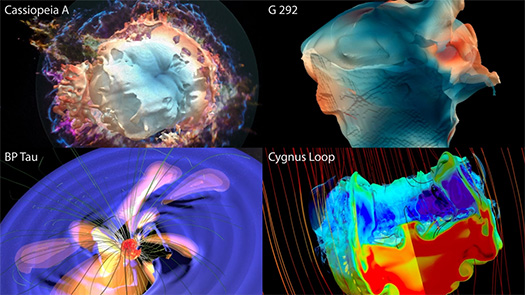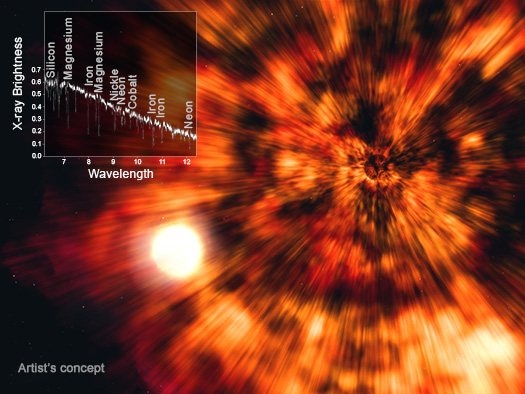Supernovas & Supernova Remnants
Supernova Remnant Video From NASA's Chandra Is Decades in Making
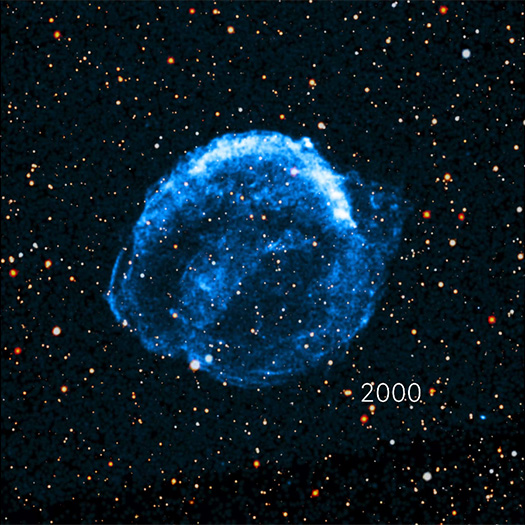
Kepler’s Supernova Remnant
More images, videos, and information
X-ray: NASA/CXC/SAO; Optical: Pan-STARRS
A new video shows changes in Kepler’s Supernova Remnant using data from NASA’s Chandra X-ray Observatory captured over more than two and a half decades with observations taken in 2000, 2004, 2006, 2014, and 2025. In this video, which is the longest-spanning one ever released by Chandra, X-rays (blue) from the telescope have been combined with an optical image (red, green, and blue) from Pan-STARRS.
Kepler’s Supernova Remnant, named after the German astronomer Johannes Kepler, was first spotted in the night sky in 1604. Today, astronomers know that a white dwarf star exploded when it exceeded a critical mass, after pulling material from a companion star, or merging with another white dwarf. This kind of supernova is known as a Type Ia and scientists use it to measure the expansion of the Universe.
Fall Collection: Before Fall Leaves, See Seasonal Offerings from NASA's Chandra
Before fall gives way to winter in the northern hemisphere, NASA’s Chandra X-ray Observatory has several images that celebrate autumn and its many delights to share. In spirit of the season, this collection gathers Chandra data with those from its telescopic family including NASA’s James Webb, Hubble, and Spitzer Space Telescopes, plus others in space and on the ground.
NASA's Chandra Releases New 3D Models of Cosmic Objects
New three-dimensional (3D) models of objects in space have been released by NASA’s Chandra X-ray Observatory. These 3D models allow people to explore — and print — examples of stars in the early and end stages of their lives. They also provide scientists with new avenues to investigate scientific questions and find insights about the objects they represent.
These 3D models are based on state-of-the-art theoretical models, computational algorithms, and observations from space-based telescopes like Chandra that give us accurate pictures of these cosmic objects and how they evolve over time.
However, looking at images and animations is not the only way to experience this data. The four new 3D printable models of Cassiopeia A (Cas A), G292.0+1.8 (G292), Cygnus Loop supernova remnants, and the star known as BP Tau let us experience the celestial objects in the form of physical structures that will allow anyone to hold replicas of these stars and their surroundings and examine them from all angles.
Finding Clues in Ruins of Ancient Dead Star With NASA's Chandra
People often think about archaeology happening deep in jungles or inside ancient pyramids. However, a team of astronomers has shown that they can use stars and the remains they leave behind to conduct a special kind of archaeology in space.
Mining data from NASA’s Chandra X-ray Observatory, the team of astronomers studied the relics that one star left behind after it exploded. This “supernova archaeology” uncovered important clues about a star that self-destructed – probably more than a million years ago.
New NASA Sonifications Listen to the Universe's Past
Your browser does not support the video tag.
Cassiopeia A Sonification
Credit: X-ray: NASA/CXC/SAO; Optical: NASA/ESA/STScI; IR: NASA/ESA/CSA/STScI/Milisavljevic et al., NASA/JPL/CalTech; Image Processing: NASA/CXC/SAO/J. Schmidt and K. Arcand; Sonification: NASA/CXC/SAO/K.Arcand, SYSTEM Sounds (M. Russo, A. Santaguida)
A quarter of a century ago, NASA released the “first light” images from the agency’s Chandra X-ray Observatory. This introduction to the world of Chandra’s high-resolution X-ray imaging capabilities included an unprecedented view of Cassiopeia A, the remains of an exploded star located about 11,000 light-years from Earth. Over the years, Chandra’s views of Cassiopeia A have become some of the telescope’s best-known images.
To mark the anniversary of this milestone, new sonifications of three images — including Cassiopeia A (Cas A) — are being released. Sonification is a process that translates astronomical data into sound, similar to how digital data are more routinely turned into images. This translation process preserves the science of the data from its original digital state but provides an alternative pathway to experiencing the data.
Chandra Peers Into Densest and Weirdest Stars

3C 58
Credit: X-ray: NASA/CXC/ICE-CSIC/A. Marino et al.; Optical: SDSS; Image Processing: NASA/CXC/SAO/J. Major
The supernova remnant 3C 58 contains a spinning neutron star, known as PSR J0205+6449, at its center. Astronomers studied this neutron star and others like it to probe the nature of matter inside these very dense objects. A new study, made using NASA’s Chandra X-ray Observatory and ESA’s XMM-Newton, reveals that the interiors of neutron stars may contain a type of ultra-dense matter not found anywhere else in the Universe.
In this image of 3C 58, low-energy X-rays are colored red, medium-energy X-rays are green, and the high-energy band of X-rays is shown in blue. The X-ray data have been combined with an optical image in yellow from the Digitized Sky Survey. The Chandra data show that the rapidly rotating neutron star (also known as a “pulsar”) at the center is surrounded by a torus of X-ray emission and a jet that extends for several light-years. The optical data shows stars in the field.
NASA's Chandra Releases Doubleheader of Blockbuster Hits
Your browser does not support the video tag.
Crab Nebula and Cassiopeia A
Credit: Cassiopeia A: X-ray: NASA/CXC/SAO; Optical: NASA/STScI; Image Processing: NASA/CXC/SAO/J. Major, A. Jubett, K. Arcand; Crab Nebula: X-ray: NASA/CXC/SAO; Image processing: NASA/CXC/SAO/J. Schmidt, J. Major, A. Jubett, K. Arcand
New movies of two of the most famous objects in the sky — the Crab Nebula and Cassiopeia A — are being released from NASA’s Chandra X-ray Observatory. Each includes X-ray data collected by Chandra over about two decades. They show dramatic changes in the debris and radiation remaining after the explosion of two massive stars in our galaxy.
The Crab Nebula, the result of a bright supernova explosion seen by Chinese and other astronomers in the year 1054, is 6,500 light-years from Earth. At its center is a neutron star, a super-dense compact object produced by the supernova. As it rotates at about 30 times per second, its beam of radiation passes over the Earth every rotation, like a cosmic lighthouse.
As the young pulsar slows down, large amounts of energy are injected into its surroundings. In particular, a high-speed wind of matter and anti-matter particles plows into the surrounding nebula, creating a shock wave that forms the ring seen in the movie. Jets from the poles of the pulsar spew X-ray emitting matter and antimatter particles in a direction perpendicular to the ring.
Stunning Echo of 800-year-old Explosion
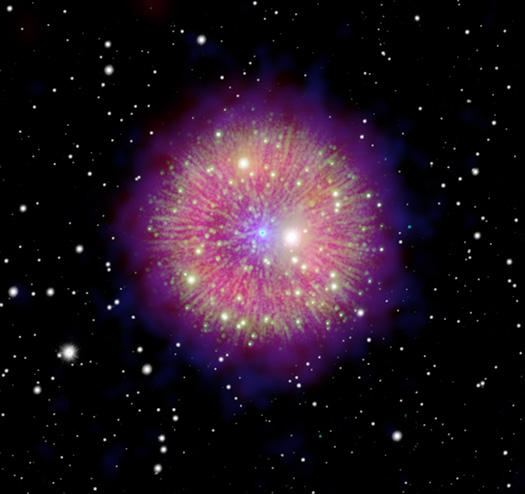
SNR 1181 / Pa 30
Credit: X-ray: (Chandra) NASA/CXC/U. Manitoba/C. Treyturik, (XMM-Newton) ESA/C. Treyturik; Optical: (Pan-STARRS) NOIRLab/MDM/Dartmouth/R. Fesen; Infrared: (WISE) NASA/JPL/Caltech/; Image Processing: Univ. of Manitoba/Gilles Ferrand and Jayanne English
In the year 1181 a rare supernova explosion appeared in the night sky, staying visible for 185 consecutive days. Historical records show that the supernova looked like a temporary ‘star’ in the constellation Cassiopeia shining as bright as Saturn.
Ever since, scientists have tried to find the supernova’s remnant. At first it was thought that this could be the nebula around the pulsar — the dense core of a collapse star — named 3C 58. However closer investigations revealed that the pulsar is older than supernova 1181.
In the last decade, another contender was discovered; Pa 30 is a nearly circular nebula with a central star in the constellation Cassiopeia. It is pictured here combining images from several telescopes. This composite image uses data across the electromagnetic spectrum and shows a spectacular new view of the supernova remnant. This allows us to marvel at the same object that appeared in our ancestors’ night sky more than 800 years ago.
NASA's IXPE Helps Researchers Maximize 'Microquasar' Findings
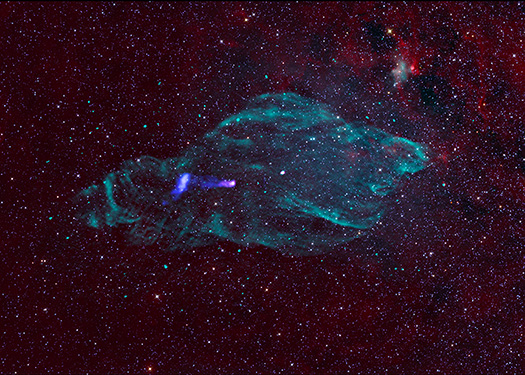
SS 433
Credit: X-ray: (IXPE): NASA/MSFC/IXPE; (Chandra): NASA/CXC/SAO; (XMM): ESA/XMM-Newton; IR: NASA/JPL/Caltech/WISE;
Radio: NRAO/AUI/NSF/VLA/B. Saxton. (IR/Radio image created with data from M. Goss, et al.);
Image Processing/compositing: NASA/CXC/SAO/N. Wolk & K. Arcand
This composite image of the Manatee Nebula captures the jet emanating from SS 433, a black hole pulling material inwards that is embedded in the supernova remnant which spawned it. Radio emission from the supernova remnant are blue-green, whereas the X-ray from IXPE, XMM-Newton and Chandra are highlighted in bright blue-purple and pink-white set against a backdrop of infrared data in red. The black hole emits twin jets of matter traveling in opposite directions at nearly the speed of light.
These jets distort the remnant’s shape into one astronomers dubbed the Manatee. The jets become bright about 100 light-years away from the black hole, where particles are accelerated to very high energies by shocks within the jet. The IXPE data shows that the magnetic field, which plays a key role in how particles are accelerated, is aligned parallel to the jet — aiding our understanding of how astrophysical jets accelerate these particles to high energies.
NASA Telescopes Chase Down "Green Monster" in Star's Debris
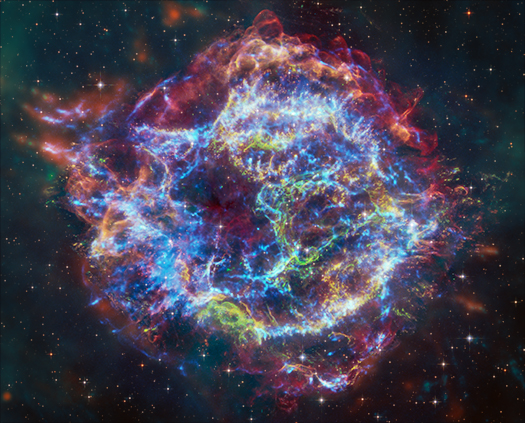
Cassiopeia A
Credit: X-ray: NASA/CXC/SAO; Optical: NASA/ESA/STScI;
IR: NASA/ESA/CSA/STScI/Milisavljevic et al., NASA/JPL/CalTech;
Image Processing: NASA/CXC/SAO/J. Schmidt and K. Arcand
For the first time astronomers have combined data from NASA’s Chandra X-ray Observatory and James Webb Space Telescope to study the well-known supernova remnant Cassiopeia A (Cas A). As described in our latest press release, this work has helped explain an unusual structure in the debris from the destroyed star called the “Green Monster”, first discovered in Webb data in April 2023. The research has also uncovered new details about the explosion that created Cas A about 340 years ago, from Earth’s perspective.


